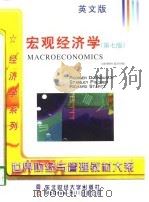《经济学原理 英文版 珍藏版》
| 作者 | (美)N.格列高里·曼昆(N.Gregory Mankiw) 编者 |
|---|---|
| 出版 | 北京:机械工业出版社 |
| 参考页数 | 797 |
| 出版时间 | 1998(求助前请核对) 目录预览 |
| ISBN号 | 7111064682 — 求助条款 |
| PDF编号 | 86579138(仅供预览,未存储实际文件) |
| 求助格式 | 扫描PDF(若分多册发行,每次仅能受理1册) |

CONTENTS1
PART I1
INTR0DUCTION1
CHAPTER 1TEN PRINCIPLES OF ECON0MICS3
How People Make Decisions4
Principle #1: People Face Tradeoffs4
Principle #2: The Cost of SOmething ls What You Give Up to Get It5
Principle #3: Rational People Think at the Margin6
Principle #4: People Respond to Incentives7
How People Interact8
Principle #5: Trade Can Make Everyone Better Off8
Principle #6: Markets Are Usually a Good Way to Organize Economic Activity9
Principle #7: Governments Can Sometimes Improve Market Outcomes10
How the Economy as a Whole works10
Principle #8: A Country's Standard of Living Depends on Its Ability to Produce Goods and Services11
Principle #9: Prices Rise When the Government Prints Too Much Money12
Principle #10: Society Faces a Short Run Tradeoff between Inflation and Unemployment13
Conclusion13
Summary14
Key Concepts14
Questions for Review15
Problems and Applications15
CHAPTER 2THINKING LIKE AN EC0NOMIST17
The Economist as Scientist18
The Scientific Method: Observation, Theory and More Observation19
The Role of Assumptions19
Economic Models20
Our First Model: The Circular-Flow Diagram21
Our Second Model: The Production Possibilities Frontier22
Microeconomics and Macroeconomics25
The Economist as Policymaker26
Positive versus Normative Analysis26
EconomistS in Washington27
Why Economists Disagree28
Differences in Scientific Judgments28
Differences in Values29
Charlatans and Cranks29
Perception versus Reality30
Let's Get Going31
Summary32
Key Concepts32
Questions for Review32
Problems and Applications33
Graphs of Two Variables: The Coordinate System34
Graph5 of a Single Variable34
Appendix: Graphing--A Brief Review34
Curves in the Coordinate System36
Slope and Elasticity39
Cause and Effect41
Omitted Variables41
Reverse Causality42
CHAPTER 3INTERDEPENDENCE AND THE GAINS FR0M TRADE45
A Parable for the Modem Economy46
Production Possibilities46
Specialization and Trade48
The Principle of Comparative Advantage50
Absolute Advantage51
Opportunity Cost and Comparative Advantage51
Comparative Advantage and Trade52
Should Michael Jordan Mow His Own Lawn?53
Applications of Comparative Advantage53
FYI: The Legacy of Adam Smith and David Ricardo54
Should the United States Trade with Other Countries?54
Conclusion55
Summary55
Key Concepts56
Questions for Review56
Problems and Applications56
PART II57
SUPPLY AND DEMAND I:HOW MARKETS W0RK59
CHAPTER 4THE MARKET F0RCES OF SUPPLY AND DEMAND61
Markets and Competition62
Competitive Markets62
Competition: Perfect and Otherwise62
Price63
Demand63
The Determinants of Individual Demand63
Income64
Prices of Related Goods64
Tastes64
Expectations64
The Demand Schedule and the Demand Curve64
Ceteris Paribus66
Market Demand versus Individual Demand66
Shifts in the Demand Curve68
CASE STUDY: Two Ways to Reduce the Quantity of Smoking Demanded69
Supply70
The Supply Schedule and the Supply Curve71
Expectations71
Technology71
Input Prices71
Price71
The Determinants of Individual Supply71
Market Supply versus Individual Supply72
Shifts in the Supply Curve73
Supply and Demand Together74
Equilibrium76
Three Steps to Analyzing Changes in Equilibrium78
Example: A Change in Demand78
Shifts in Curves versus Movements along Curves80
Example: A Change in Supply80
Example:A Change in Both Supply and Demand81
Conclusion: How Prices Allocate Resources81
lN THE NEWS: Supply, Demand, and the Price of Paper--Pulp Reality83
Summary84
Key Concepts85
Questions for Review85
Problems and Applications85
CHAPTER 5ELASTICITY AND ITS APPUCATI0N89
The Elasticity of Demand90
The Price Elasticity of Demand and Its Determinants90
Necessities versus Luxuries90
Availability of Close Substitutes90
Definition of the Market90
Time Horizon91
Computing the Price Elasticity of Demand91
FYI: Calculating E1asticities Using the Midpoint Method92
The Variety of Demand Curves92
Total Revenue and the Price Elasticity of Demand94
The Income Elasticity of Demand96
CASE STUDY: Pricing Admission to a Museum96
FYI: Elasticity and Total Revenue along a Linear Demand Curve97
IN THE NEWS: On the Road with Elasticity--For Whom the Booth Tolls, Price Really Does Matter98
The Elasticity of Supply99
The Price Elasticity of Supply and Its Determinants99
Computing the Price Elasticity of Supply99
The Variety of Supply Curves100
Three Applications of Supply, Demand, and Elasticity102
Can Good News fOr Farming Be Bad News fOr Farmers?103
Why Did OPEC Fail to Keep the Price of Oil High?105
Does Drug Interdiction Increase or Decrease Drug-Related Crime?106
Conclusion108
Summary108
Problems and Applications109
Questions for Review109
Key Concepts109
CHAPTER 6SUPPLY DEMAND, AND GOVERNMENT POLICIES111
Controls on Prices112
How Price Ceilings Affect Market Outcomes112
CASE STUOY: Lines at the Gas Pump113
CASE STUDY: Rent Control in the Short Run and Long Run115
IN THE NEWS: Rent Control in New York City--Home Free: Some Rich and Famous of New York City Bask in Shelter of Rent Law116
How Price Floors Affect Market Outcomes117
CASE STUDY: The Minimum Wage118
Evaluating Price Controls120
Taxes121
How Taxes on Buyers Affect Market Outcomes122
How Taxes on Sellers Affect Market Outcomes123
CASE STU0Y: Can Congress Distribute the Burden of a Payroll Tax?124
Elasticity and Tax Incidence125
CASE STUDY: Who Pays the Luxury Tax?127
Conclusion128
Key Concepts128
Questions for Review128
Summary128
Problems and Applications129
PART III129
SUPPLY AND DEMAND II:MARKETS AND WELFARE131
CHAPTER 7CONSUMERS, PRODUCERS, AND THE EFFICIENCY 0F MARKETS133
Willingness to Pay134
Consumer Surplus134
Using the Demand Curve to Measure Consumer Surplus135
How a Lower Price Raises Consumer Surplus138
What Does Consumer Surplus Measure?138
Producer Surplus140
Cost and the Willingness to Sell140
Using the Supply Curve to Measure Producer Surplus141
How a Higher Price Raises Producer Surplus143
The Benevolent Social Planner144
Market Efficiency144
FYI: The Invisible Hand of the Marketplace145
Evaluating the Market Equilibrium146
lN THE NEWS: Ticket Scalping--Tickets? Supply Meets Demand on Sidewalk148
Conclusion: Market Efficiency and Market Failure150
Summary151
Key Concepts151
Questions for Review151
Problems and Applications151
CHAPTER 8APPLICATI0N: THE COSTS 0F TAXATION155
How a Tax Affects Market Participants156
The Deadweight Loss of Taxation156
Welfare without a Tax157
Welfare with a Tax158
Changes in Welfare158
Deadweight Losses and the Gains from Trade159
The Determinants of the Deadweight Loss160
CASE STUDY: The Deadweight Loss of Taxes on Labor162
CASE STUDY: Henry George and the Tax on Land163
Deadweight Loss and Tax Revenue as Taxes vary164
CASE STUDY: The Laffer Curve and Supply-Side Economics166
Conclusion168
IN THE NEWS: Should Ukraine Cut Tax Rates to Raise Tax Revenue?--A Big Tax Cut to Lyt the Economy-Not Her, in Ukraine169
PrOblems and Applications170
Questions for Review170
Key Concepts170
Summary170
CHAPTER 9APPLICATION: INTERNATIONAL TRADE173
The Determinants of Trade174
The Equilibrium without Trade174
The World Price and Comparative Advantage175
FYI: Comparing Prices and Comparative Advantage175
The Winners and Losers frOm Trade176
The Gains and Losses of an Exporting Country176
The Gains and Losses of an ImPOrting Country179
The Effects of a Tariff181
The Effects of an IMport Quota182
The Lessons for Trade Policy185
The Arguments for Restricting Trade186
The Jobs Argument186
The Infant-Industry Argumen187
The National-Security Argument187
President Wins Tomato Accord for Flaridians: Mexico Agrees to End Low-Price Shipments188
IN THE NEWS: NAFTA and Mexican Tomatoes-188
The Unfair-Competition Argument189
The Protection-as-a-Bargaining-Chip Argument189
CASE STUDY: GATT and the Multilateral Approach to Free Trade189
IN THE NEWS: A Chicken Invasion--U.S. Chicken in Every Pot? Nyet! Russians Cry Foul190
Conclusion191
Summary192
Key Concepts192
Questions for Review193
Problems and Applications193
PART IV197
THE ECONOMICS OF THE PUBLIC SECT0R197
CHAPTER 10EXTERNALITIES199
Welfare Economics:A Recap201
Externalities and Market Inefficiency201
Negative Externalities in Production202
Positive Externalities in Production203
CASE STUDY: The Debate over Technology Policy204
Externalities in Consumption205
Private Solutions to Externalities207
The Types of Private Solutions207
IN THE NEWS: An Outraged Citizen Speaks Out-Smokers, Pick UP Your Butts208
The Coase Theorem208
Why Private Solutions DO NOt Always Work209
Public POlicies toward Externalities210
Regulation210
Pigovian Taxes and Subsidies211
Tradable Pollution Permits212
1998《经济学原理 英文版 珍藏版》由于是年代较久的资料都绝版了,几乎不可能购买到实物。如果大家为了学习确实需要,可向博主求助其电子版PDF文件(由(美)N.格列高里·曼昆(N.Gregory Mankiw) 1998 北京:机械工业出版社 出版的版本) 。对合法合规的求助,我会当即受理并将下载地址发送给你。
高度相关资料
-

- 读曲随笔
- 1999 上海:上海文艺出版社
-

- 经济学原理:英文版
- 1998年07月第1版
-

- 宏观经济学(英文版)
- 1999年03月第1版 机械工业出版社
-

- 读者 珍藏版 R版
- 读者杂志社
-

- 经济学原理 第7版
- 1970
-

- 中国素女经 珍藏版
- 江南出版社
-

- 国际经济中的经理 英文版 第7版
- 1998 北京:清华大学出版社
-

- 经济学 英文版·第18版
- 机械工业出版社
-

- 国际经济学 英文版·第3版
- 1998 北京:机械工业出版社
-

- 宏观经济学 第7版 英文版
- 1998 沈阳:东北财经大学出版社;McGraw-Hill出版公司
-

- 国际经济学 第6版 英文版
- 1998 沈阳:东北财经大学出版社
-

- 微观经济学 英文版 第3版
- 1998 沈阳:东北财经大学出版社;McGraw-Hill出版公司
-

- 经济学 原理与政策 英文版·第7版
- 1998 北京:机械工业出版社
-

- 审计学原理 英文版·第12版
- 1998 北京:机械工业出版社
-

- 现代管理宗师德鲁克文选 英文版 珍藏版
- 1999 北京:机械工业出版社
提示:百度云已更名为百度网盘(百度盘),天翼云盘、微盘下载地址……暂未提供。➥ PDF文字可复制化或转WORD